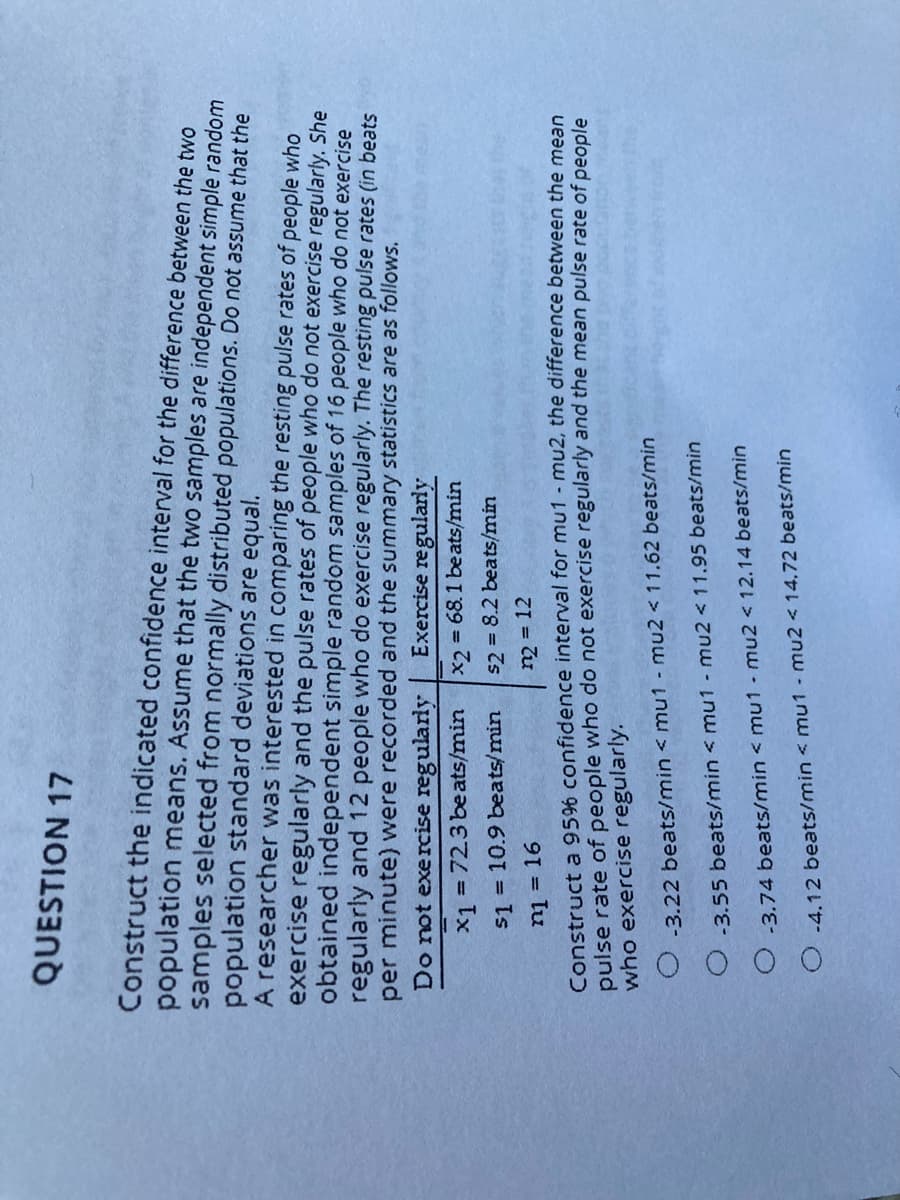Construct the indicated confidence interval for the difference between the two population means. Assume that the two samples are independent simple random samples selected from normally distributed populations. Do not assume that the population standard deviations are equal. A researcher was interested in comparing the resting pulse rates of people who exercise regularly and the pulse rates of people who do not exercise regularly. She obtained independent simple random samples of 16 people who do not exercise regularly and 12 people who do exercise regularly. The resting pulse rates (in beats per minute) were recorded and the summary statistics are as follows. Do not exercise regularly Exercise regularly x1 72.3 beats/min x2 = 68.1 beats/min %3D %3D s1 = 10.9 beats/min s2 8.2 beats/min %3D %3D nį = 16 n2 = 12 %3D Construct a 95% confidence interval for mu1 - mu2, the difference between the mean pulse rate of people who do not exercise regularly and the mean pulse rate of people who exercise regularly. -3.22 beats/min < mu1 - mu2 < 11.62 beats/min -3.55 beats/min < mu1 - mu2 < 11.95 beats/min -3.74 beats/min < mu1 - mu2 < 12.14 beats/min 7 heats/min < mu1 - mu2 < 14,72 beats/min
Construct the indicated confidence interval for the difference between the two population means. Assume that the two samples are independent simple random samples selected from normally distributed populations. Do not assume that the population standard deviations are equal. A researcher was interested in comparing the resting pulse rates of people who exercise regularly and the pulse rates of people who do not exercise regularly. She obtained independent simple random samples of 16 people who do not exercise regularly and 12 people who do exercise regularly. The resting pulse rates (in beats per minute) were recorded and the summary statistics are as follows. Do not exercise regularly Exercise regularly x1 72.3 beats/min x2 = 68.1 beats/min %3D %3D s1 = 10.9 beats/min s2 8.2 beats/min %3D %3D nį = 16 n2 = 12 %3D Construct a 95% confidence interval for mu1 - mu2, the difference between the mean pulse rate of people who do not exercise regularly and the mean pulse rate of people who exercise regularly. -3.22 beats/min < mu1 - mu2 < 11.62 beats/min -3.55 beats/min < mu1 - mu2 < 11.95 beats/min -3.74 beats/min < mu1 - mu2 < 12.14 beats/min 7 heats/min < mu1 - mu2 < 14,72 beats/min
MATLAB: An Introduction with Applications
6th Edition
ISBN:9781119256830
Author:Amos Gilat
Publisher:Amos Gilat
Chapter1: Starting With Matlab
Section: Chapter Questions
Problem 1P
Related questions
Topic Video
Question

Transcribed Image Text:QUESTION 17
Construct the indicated confidence interval for the difference between the two
population means. Assume that the two samples are independent simple random
samples selected from normally distributed populations. Do not assume that the
population standard deviations are equal.
A researcher was interested in comparing the resting pulse rates of people who
exercise regularly and the pulse rates of people who do not exercise regularly. She
obtained independent simple random samples of 16 people who do not exercise
regularly and 12 people who do exercise regularly. The resting pulse rates (in beats
per minute) were recorded and the summary statistics are as follows.
Do not exercise regularly
Exercise regularly
x1 = 723 beats/min
x2 = 68.1 beats/min
%3D
s1 = 10.9 beats/min
s2 = 8.2 beats/min
ni = 16
n2 = 12
Construct a 95% confidence interval for mu1 - mu2, the difference between the mean
pulse rate of people who do not exercise regularly and the mean pulse rate of people
who exercise regularly.
-3.22 beats/min < mu1 - mu2 < 11.62 beats/min
-3.55 beats/min < mu1 - mu2 <11.95 beats/min
-3.74 beats/min < mu1 - mu2 < 12.14 beats/min
-4.12 beats/min < mu1 - mu2 < 14,72 beats/min
Expert Solution
This question has been solved!
Explore an expertly crafted, step-by-step solution for a thorough understanding of key concepts.
This is a popular solution!
Trending now
This is a popular solution!
Step by step
Solved in 2 steps

Knowledge Booster
Learn more about
Need a deep-dive on the concept behind this application? Look no further. Learn more about this topic, statistics and related others by exploring similar questions and additional content below.Recommended textbooks for you

MATLAB: An Introduction with Applications
Statistics
ISBN:
9781119256830
Author:
Amos Gilat
Publisher:
John Wiley & Sons Inc

Probability and Statistics for Engineering and th…
Statistics
ISBN:
9781305251809
Author:
Jay L. Devore
Publisher:
Cengage Learning

Statistics for The Behavioral Sciences (MindTap C…
Statistics
ISBN:
9781305504912
Author:
Frederick J Gravetter, Larry B. Wallnau
Publisher:
Cengage Learning

MATLAB: An Introduction with Applications
Statistics
ISBN:
9781119256830
Author:
Amos Gilat
Publisher:
John Wiley & Sons Inc

Probability and Statistics for Engineering and th…
Statistics
ISBN:
9781305251809
Author:
Jay L. Devore
Publisher:
Cengage Learning

Statistics for The Behavioral Sciences (MindTap C…
Statistics
ISBN:
9781305504912
Author:
Frederick J Gravetter, Larry B. Wallnau
Publisher:
Cengage Learning

Elementary Statistics: Picturing the World (7th E…
Statistics
ISBN:
9780134683416
Author:
Ron Larson, Betsy Farber
Publisher:
PEARSON

The Basic Practice of Statistics
Statistics
ISBN:
9781319042578
Author:
David S. Moore, William I. Notz, Michael A. Fligner
Publisher:
W. H. Freeman

Introduction to the Practice of Statistics
Statistics
ISBN:
9781319013387
Author:
David S. Moore, George P. McCabe, Bruce A. Craig
Publisher:
W. H. Freeman